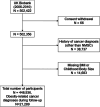Association of childhood-to-adulthood body size change with cancer risk: UK Biobank prospective cohort
- PMID: 40335963
- PMCID: PMC12060570
- DOI: 10.1186/s12916-025-04052-8
Association of childhood-to-adulthood body size change with cancer risk: UK Biobank prospective cohort
Abstract
Background: While excess weight in adulthood and childhood has been associated with increased cancer risk, the link between body size change from childhood to adulthood and cancer risk requires further investigation. We aimed to examine the associations of childhood-to-adulthood body size change with the risk of obesity-related cancers.
Methods: We used data from the UK Biobank, a prospective population-based cohort study. The main exposure was childhood-to-adulthood body size change, constructed from self-reported body size at age 10 (categories: thinner, average, and plumper than average) and measured body mass index (BMI) at recruitment (normal weight, overweight, and obesity). Primary outcome was obesity-related cancer (13 different cancer types).
Results: Among 448,936 participants (mean [SD] age, 56.2 [8.1] years; 240,023 were female [53.5%]) and during a median follow-up of 11.7 years (interquartile range [10.9-12.4]), 21,289 incident obesity-related cancer cases were recorded. Most participants were either overweight (42.6%) or had obesity (24.4%) at recruitment, while only a minority (16.0%) reported to have been plumper than average at age 10. Having a larger body size in childhood was strongly associated with having overweight or obesity in adulthood. Compared to participants with average childhood and normal adulthood body size, participants with overweight or obesity in adulthood had a significantly increased risk of obesity-related cancers, regardless of the childhood body size (adjusted hazard ratios ranged from 1.15 [95% CI, 1.06-1.24] to 1.61 [95% CI, 1.50-1.73]). The strength of the association was mostly determined by adulthood BMI, and similar patterns were observed for colorectal, endometrial, kidney, pancreatic, and esophageal cancer. However, a larger body size in childhood was associated with a lower risk of postmenopausal breast cancer (adjusted hazard ratio, 0.86 [95% CI, 0.79-0.93]).
Conclusions: While larger body size in childhood predisposes individuals to overweight and obesity in adulthood, maintaining a healthy weight in adulthood may help mitigate the risk of obesity-related cancers. Our findings highlight the importance of preventing and reducing overweight and obesity in adulthood for primary cancer prevention.
Keywords: Obesity; Overweight; Body mass index; Cancer.
© 2025. The Author(s).
Conflict of interest statement
Declarations. Ethics approval and consent to participate.: The UK Biobank was approved by the North West Multi-center Research Ethics Committee (MREC) as a Research Tissue Bank (RTB) approval (renewed approval in 2021:21/NW/0157). Consent for publication: Not applicable. Competing interests: The authors declare no competing interests.
Figures
Similar articles
-
Are associations of adulthood overweight and obesity with all-cause mortality, cardiovascular disease, and obesity-related cancer modified by comparative body weight at age 10 years in the UK Biobank study?Int J Obes (Lond). 2025 May;49(5):902-914. doi: 10.1038/s41366-025-01718-4. Epub 2025 Jan 23. Int J Obes (Lond). 2025. PMID: 39843619 Free PMC article.
-
Associations of childhood-to-adulthood body size trajectories and genetic susceptibility with the risks of osteoarthritis: a population-based cohort study of UK Biobank data.Lancet Glob Health. 2023 Mar;11 Suppl 1:S2. doi: 10.1016/S2214-109X(23)00087-6. Lancet Glob Health. 2023. PMID: 36866477
-
Childhood body size, adulthood adiposity, underlying mechanisms, and risk of incident hypertension: a prospective cohort study of 180,527 participants.BMC Med. 2025 Jan 27;23(1):47. doi: 10.1186/s12916-025-03884-8. BMC Med. 2025. PMID: 39871294 Free PMC article.
-
Childhood, adolescent, and adulthood adiposity are associated with risk of PCOS: a Mendelian randomization study with meta-analysis.Hum Reprod. 2023 Jun 1;38(6):1168-1182. doi: 10.1093/humrep/dead053. Hum Reprod. 2023. PMID: 37015099 Free PMC article.
-
UK Biobank: a globally important resource for cancer research.Br J Cancer. 2023 Feb;128(4):519-527. doi: 10.1038/s41416-022-02053-5. Epub 2022 Nov 19. Br J Cancer. 2023. PMID: 36402876 Free PMC article. Review.
References
-
- World Health Organization. Obesity: preventing and managing the global epidemic. 2000. https://apps.who.int/iris/handle/10665/42330. Accessed 29 Feb 2024. - PubMed
-
- Renehan AG, Tyson M, Egger M, Heller RF, Zwahlen M. Body-mass index and incidence of cancer: a systematic review and meta-analysis of prospective observational studies. The Lancet. 2008;371:569–78. - PubMed
MeSH terms
LinkOut - more resources
Full Text Sources
Medical




